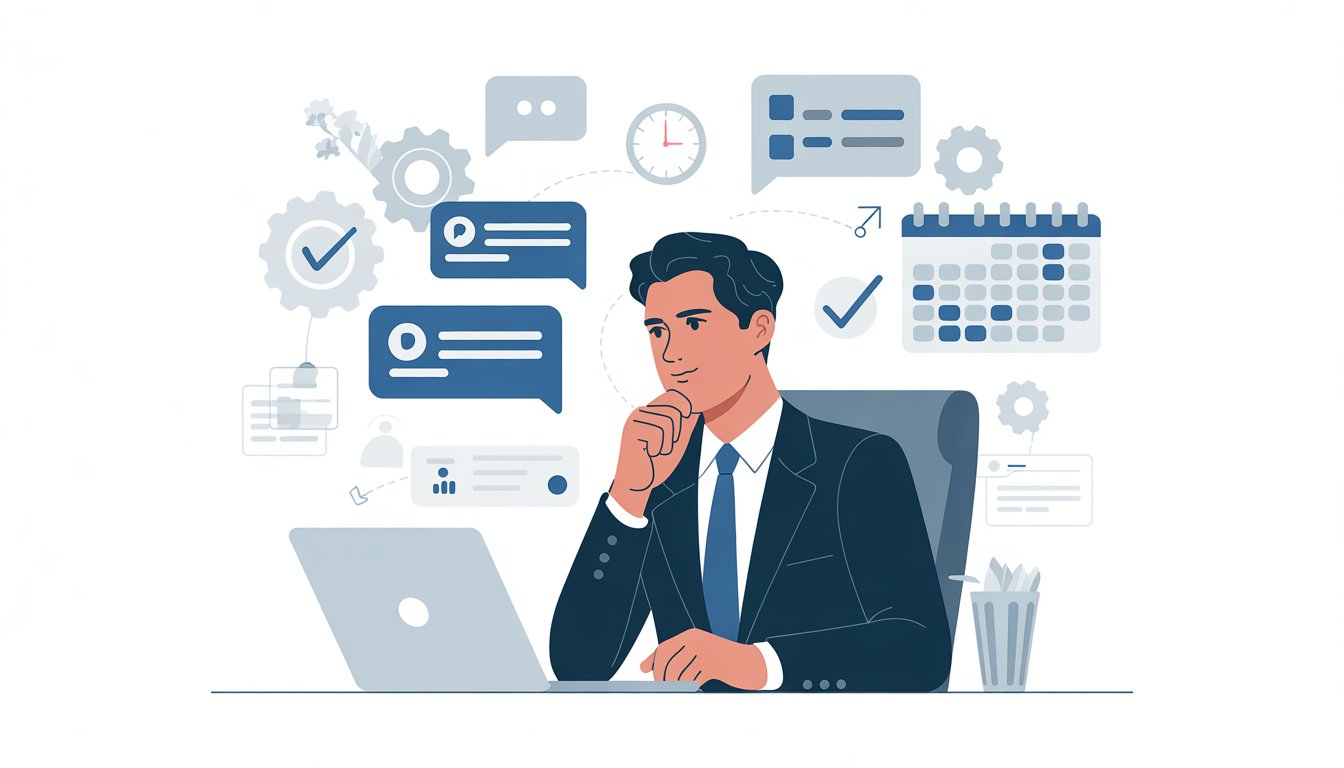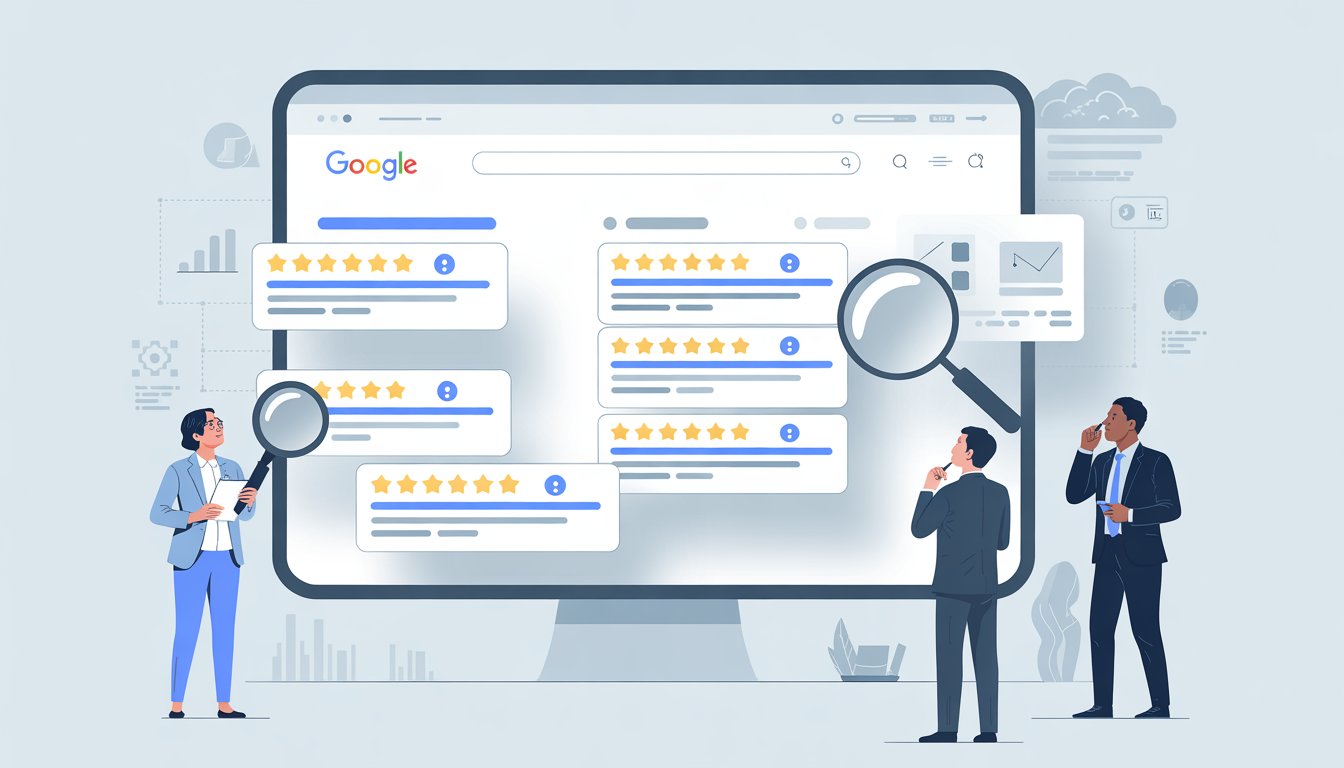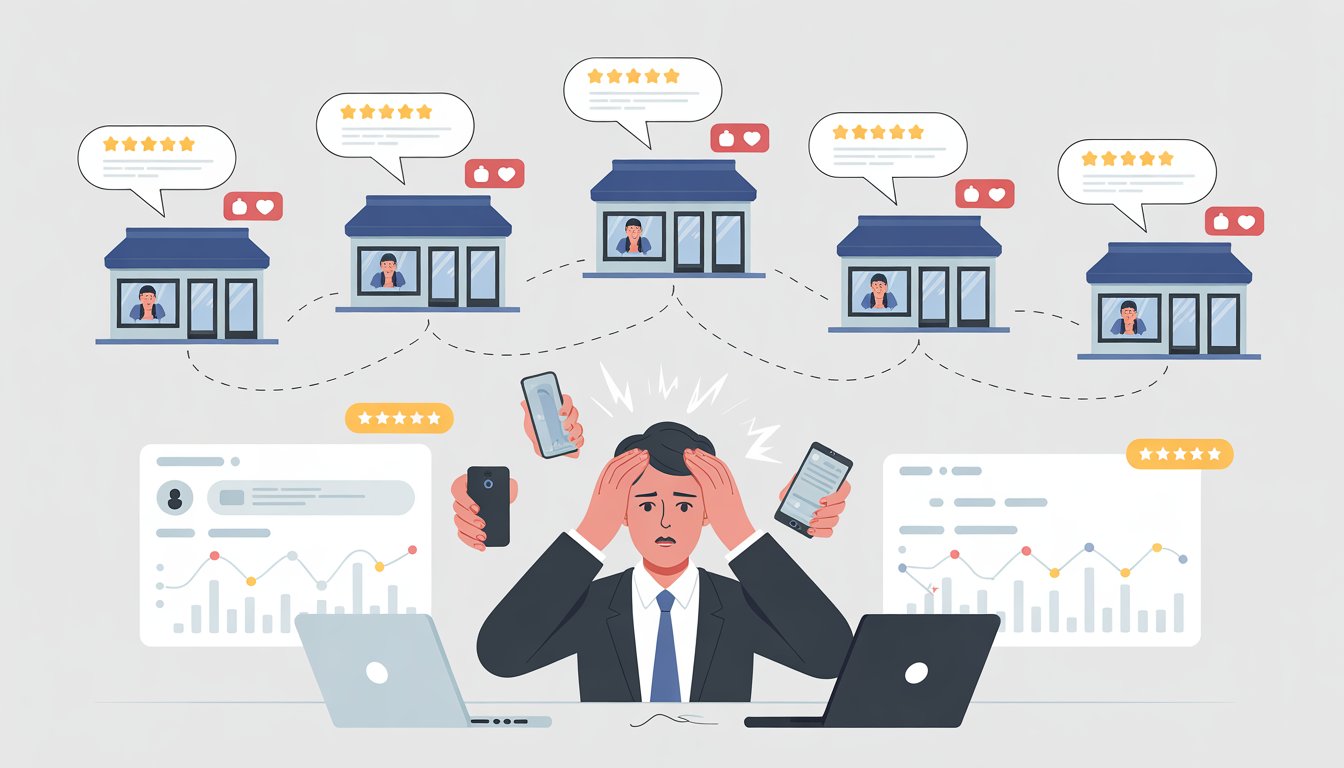Many business owners use the terms "feedback" and "reviews" as if they mean the same thing, but they serve very different purposes for your business. Understanding when to ask for each one can make or break your customer relationship strategy.
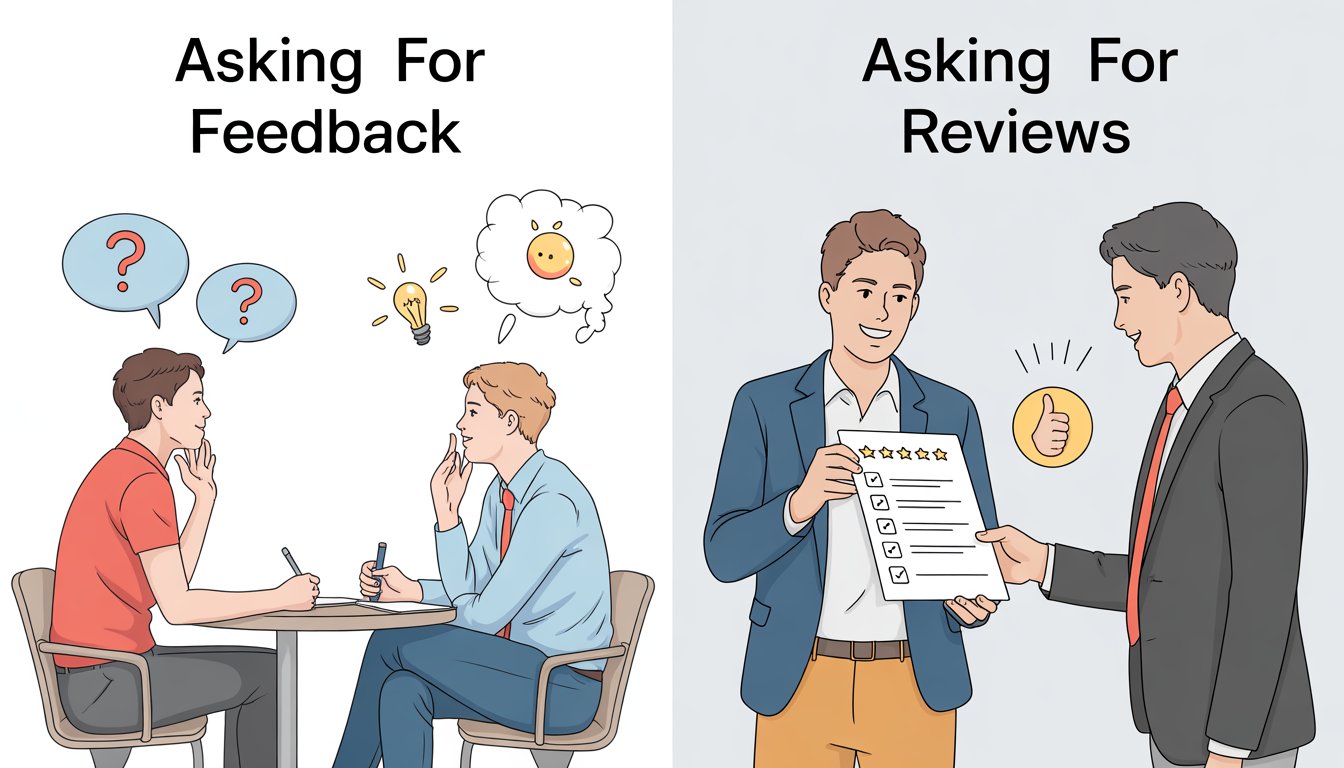
Feedback is private information you actively request from customers to improve your products or services, while reviews are public opinions customers share to help other buyers make decisions. Feedback helps you fix problems behind the scenes, but reviews build trust and credibility for future customers.
The timing and approach for requesting each one requires different strategies. Ask for feedback too early and you might miss important insights.
Ask for reviews at the wrong moment and you could end up with negative public comments that hurt your reputation.
Key Takeaways
- Feedback is private and helps you improve your business internally, while reviews are public and influence potential customers
- You should ask for feedback to identify problems and make improvements, but ask for reviews to build social proof and trust
- The best approach is to collect feedback first, address any issues, then request public reviews from satisfied customers
Core Differences Between Feedback and Reviews
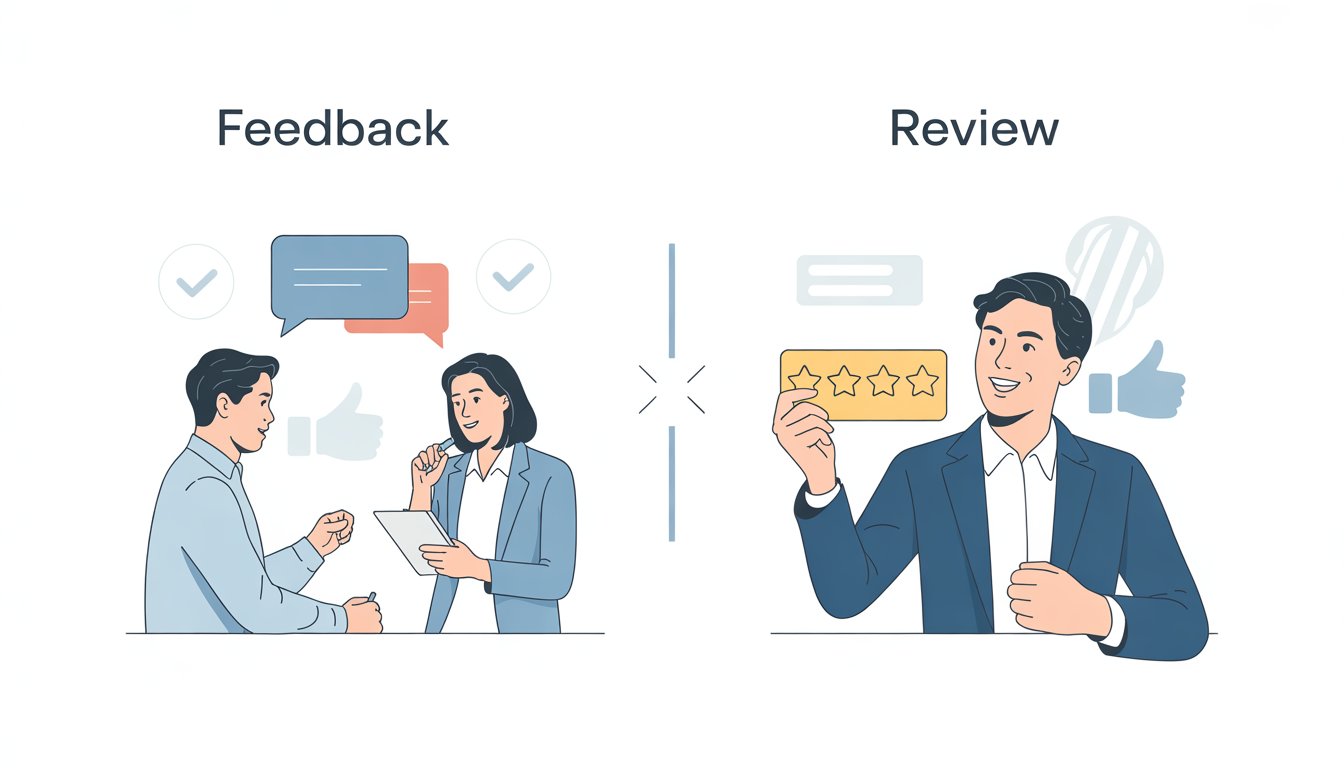
Feedback focuses on helping you improve your business, while reviews help other customers make buying decisions. Each serves different people and has different goals.
Definition of Feedback
Feedback is information customers give directly to you about your product or service. It helps you understand what works well and what needs fixing.
Customer feedback is usually private. You ask specific questions about their experience.
This might include surveys, phone calls, or email responses. The main goal is improvement.
You want honest opinions about:
- What customers liked or disliked
- Problems they faced
- Ideas for making things better
- How their customer experience could be improved
Feedback often stays between you and your customer. It's like having a private conversation about how to do better next time.
You control when and how you ask for feedback. Most customers will share detailed thoughts when asked directly.
Definition of Reviews
Reviews are public comments customers write for other potential buyers to read. They appear on websites, social media, or review platforms.
Reviews often include a star rating system. Customers rate their experience from one to five stars.
They also write comments explaining their rating. Other customers use reviews to decide if they want to buy from you.
Reviews build trust and help people feel confident about their choices. Reviews happen naturally after a purchase.
Customers choose when to write them without you asking. However, you can encourage customers to leave reviews.
Both positive and negative reviews appear publicly. You cannot control what customers write or when they post reviews.
Key Distinctions in Purpose
The biggest difference is who benefits from each type of response. Feedback benefits you directly. It gives you specific information to improve your business.
You can fix problems and make better products or services. Reviews benefit other customers. They help potential buyers make informed decisions about purchasing from you.
Timing matters too. Ask for feedback first to fix any problems.
Then ask satisfied customers to leave public reviews. Feedback should be anonymous and private.
This encourages honest responses. Reviews are public and tied to the customer's name or account.
You can use feedback to prevent negative reviews. Fix issues customers mention in feedback before they write public complaints.
Purpose and Goals of Asking for Feedback
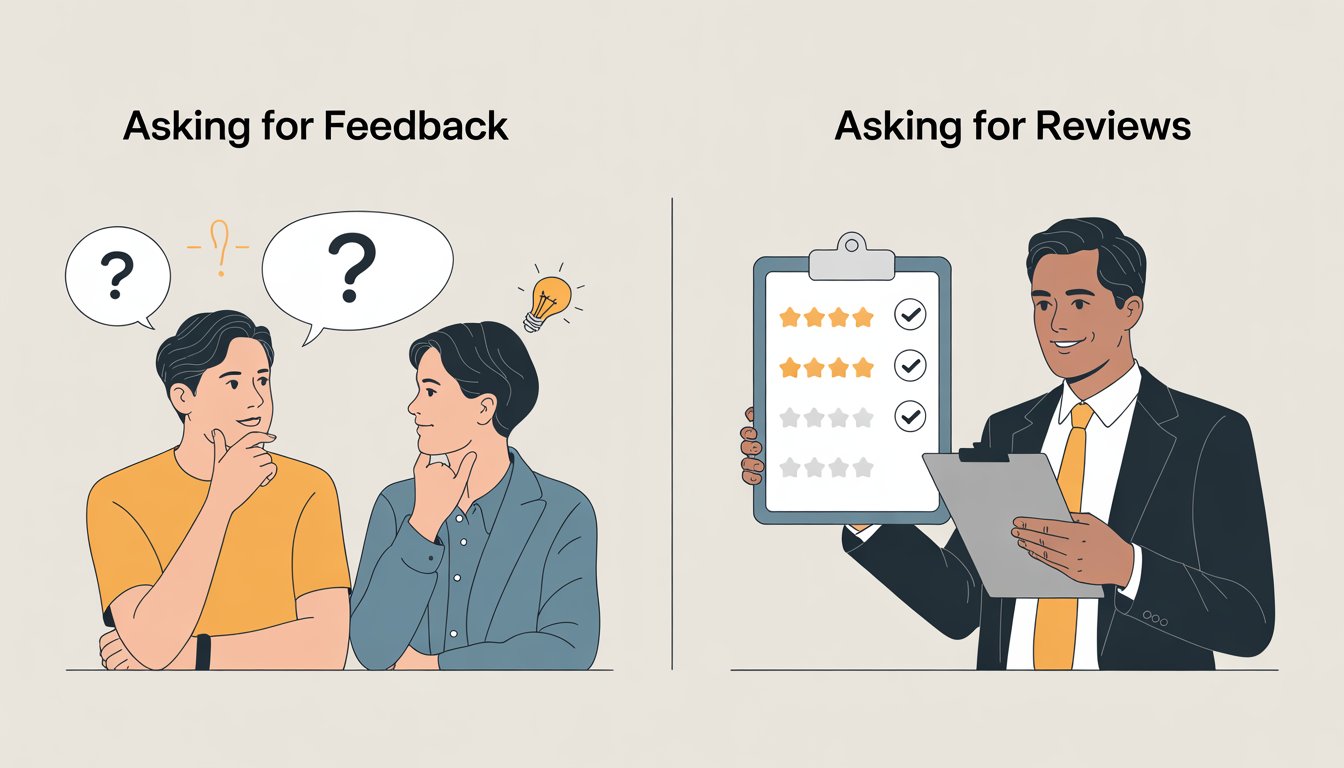
When you ask for feedback, you gain direct access to customer thoughts and experiences that drive business improvements. This process helps you map customer interactions, collect specific data for decision-making, and boost overall satisfaction levels.
Understanding the Customer Journey
Asking for feedback gives you a clear view of how customers move through your business processes. You can see where they face problems and what works well for them.
Feedback reveals specific touchpoints where customers interact with your brand. These might include your website, customer service calls, or product delivery.
Each point offers chances to improve. You can use a feedback tool to track these interactions.
This helps you build a complete picture of the customer experience. Key journey stages to focus on:
- First contact with your business
- Purchase or sign-up process
- Product or service use
- Support interactions
- Post-purchase follow-up
When you understand these stages, you can fix pain points before they hurt customer loyalty. You also discover what customers value most about working with you.
Internal Insights and Actionable Data
Feedback provides concrete data you can use to make smart business choices. Unlike reviews, which are public opinions, feedback gives you private information to work with internally.
You control what questions to ask and how to gather responses. This means you get the exact information you need for specific problems or goals.
Feedback helps you measure important metrics like NPS scores. These numbers show how likely customers are to recommend your business to others.
Types of actionable data you collect:
- Product feature requests
- Service quality ratings
- Process improvement suggestions
- Pricing feedback
- Communication preferences
This data lets you prioritize which changes will have the biggest impact. You can also track improvements over time to see if your efforts are working.
Enhancing Customer Satisfaction
Regular feedback requests show customers that you care about their opinions. This builds stronger relationships and increases customer satisfaction levels.
When you act on feedback, customers see real changes based on their input. This makes them feel heard and valued by your business.
You can catch small problems before they become big issues. Unhappy customers who share feedback often give you a chance to fix things before they leave.
Satisfaction benefits include:
- Higher retention rates
- Increased customer loyalty
- Better word-of-mouth referrals
- Reduced customer service costs
Asking for feedback also helps you identify your happiest customers. These people often become your best advocates and sources of positive reviews later.
Purpose and Benefits of Asking for Reviews
Reviews serve as public testimonials that help businesses build trust and credibility with potential customers. They create a powerful form of social proof that directly impacts how people view your business and whether they choose to buy from you.
Building Online Reputation
Your online reputation depends heavily on customer reviews. When you ask for reviews, you actively shape how your business appears online.
Positive reviews boost your credibility. They show that real customers had good experiences with your products or services.
This builds trust with people who have never heard of your business before. Reviews also help you control damage to your reputation.
When you ask satisfied customers to leave feedback, their positive comments can outweigh any negative reviews you might receive. The star rating system matters.
Most review platforms use a 5-star system that customers recognize and trust. Higher ratings make your business look more reliable and professional.
Providing Social Proof
Social proof happens when people look at what others do to decide what they should do. Reviews create this effect for your business.
88% of consumers check reviews when finding local businesses. This shows how much people rely on other customers' opinions before making choices.
When potential customers see positive reviews, they feel more confident about buying from you. They think that if other people had good experiences, they probably will too.
Reviews work like recommendations from friends. People trust what other customers say more than what businesses say about themselves.
This makes reviews very powerful for attracting new customers.
Influencing Purchase Decisions
Reviews directly affect whether people buy from you or choose a competitor instead. 92% of consumers hesitate to buy when no reviews are available.
This means that having no reviews can hurt your sales just as much as having bad reviews. Reviews help customers feel sure about their purchase decisions.
When people see that others were happy with their purchases, they worry less about making a mistake. Reviews reduce buyer doubt.
They answer common questions and concerns that potential customers might have. This makes people more likely to complete their purchases instead of leaving your website.
Methods of Collecting Feedback vs. Reviews
The way you collect feedback differs greatly from how you gather reviews. Feedback uses structured surveys and direct outreach, while reviews typically come from unsolicited customer responses after purchases.
Solicited vs. Unsolicited Input
Feedback collection is mostly solicited. You actively reach out to customers through email campaigns, pop-up surveys, or follow-up messages.
This lets you target specific customers at key moments in their journey. Reviews are usually unsolicited.
Customers leave them on their own after using your product or service. You can encourage reviews, but customers decide when and if they want to share their thoughts.
The timing matters too. You can send feedback requests right after delivery or during product use.
Reviews happen whenever customers feel motivated to share their experience.
Collection TypeFeedbackReviewsInitiationBusiness-drivenCustomer-drivenTimingControlledRandomResponse RateHigherLower
Structured and Unstructured Approaches
Feedback uses structured methods. You create specific questions, rating scales, and NPS surveys.
This gives you consistent data that's easy to analyze and compare over time. Common structured feedback includes:
- Customer satisfaction scores
- Net Promoter Score surveys
- Product feature ratings
- Service quality assessments
Reviews follow unstructured formats. Customers write whatever they want about their experience.
They might focus on shipping, product quality, or customer service - you can't control what they mention. This makes reviews more authentic but harder to analyze.
You get honest opinions but lose the ability to measure specific metrics consistently.
Tools and Software Solutions
Feedback tools focus on survey creation and data analysis. Popular options include SurveyMonkey, Typeform, and specialized customer experience platforms.
These tools help you design questions and track response patterns. Most feedback tools include:
- Survey builders
- Response tracking
- Analytics dashboards
- Email integration
Review software manages public testimonials and ratings. These platforms like Trustpilot, Google Reviews, or review software built into e-commerce sites focus on display and moderation features.
Review software typically offers:
- Review collection widgets
- Moderation controls
- Display customization
- Reputation monitoring
Many businesses use both types of tools. Feedback tools help improve products internally, while review software builds public trust and credibility.
Impact on Customer Experience and Business Growth
Both feedback and reviews directly shape how customers feel about your business and can fuel long-term growth. Feedback helps you fix problems before they hurt customer relationships, while reviews build trust that brings in new customers.
Improving Customer Loyalty
Customer feedback creates stronger bonds between you and your customers. When you ask for their opinions, you show that their thoughts matter to you.
This makes customers feel valued and heard. They see that you care about their experience beyond just making a sale.
Acting on feedback builds even stronger customer loyalty. If a customer tells you about a problem and you fix it, they become more likely to stay with your business.
Customer reviews also boost loyalty in a different way. When you respond to reviews publicly, other customers see that you care about solving problems.
This builds trust across your entire customer base. People feel more confident buying from businesses that actively engage with customer concerns.
Reviews create a community feeling around your brand. Customers who leave positive reviews become advocates for your business.
Driving Business Improvements
Feedback gives you clear direction for making your products and services better. You learn exactly what customers want changed or improved.
This helps you make smart business decisions. Instead of guessing what might work, you have real data from actual customers.
Customer experience improves when you use feedback to fix common problems. You can spot patterns in what customers complain about most.
Reviews show you how your changes affect real customers. When you fix something based on feedback, you often see it reflected in newer reviews.
Both feedback and reviews help you stay ahead of competitors. You learn what customers value most and can focus your efforts there.
Best Practices for Requesting Feedback and Reviews
The success of your request depends on proper timing and ethical practices. These two factors determine response rates and maintain trust with your audience.
Timing and Framing Your Request
Choose the right moment in the customer journey. Ask for feedback immediately after interactions when details are fresh.
Request reviews 24-48 hours after purchase when satisfaction is high but experience remains clear. Frame requests based on your goal.
For feedback, ask specific questions about performance or processes. For reviews, request sharing experiences with future customers.
Personalize your approach. Use the customer's name and reference their specific purchase or interaction.
Generic messages get ignored more often than personalized ones. Keep requests short and simple.
Long emails reduce response rates significantly. State your request clearly in the first sentence.
Provide clear instructions. Include direct links to review sites or feedback forms.
Tell customers exactly what you want them to do and how long it will take. Time your follow-ups carefully.
Send one gentle reminder after 5-7 days if needed. Multiple follow-ups can damage relationships.
Ethical Considerations
Never offer incentives for positive reviews. This violates most platform policies and creates fake social proof.
It can result in review removal and account penalties.
Accept all feedback honestly. Don't cherry-pick only positive responses.
Negative feedback provides valuable improvement opportunities.
Respond to criticism professionally. Address negative reviews quickly and offer solutions.
This shows future customers you care about problems.
Respect privacy and preferences. Include easy opt-out options in all communications.
Some customers prefer not to leave public reviews.
Be transparent about your request. Don't disguise review requests as surveys or hide your intentions.
Clear communication builds trust.
Follow platform guidelines. Each review site has specific rules about requesting reviews.
Violating these can harm your business profile.
Frequently Asked Questions
Understanding the differences between feedback and reviews involves knowing when to use each approach and how they serve different purposes.
These distinctions affect response quality, personal growth, and business outcomes.
How does soliciting advice differ from requesting feedback in terms of the response quality?
When you ask for advice, people focus on solutions and future actions.
They think about what you should do next and provide specific recommendations.
Feedback requests often lead to evaluations of past performance.
People tend to judge what you already did rather than helping you improve.
Advice-seeking generates more actionable responses.
The person giving advice feels responsible for helping you succeed and puts more thought into their suggestions.
Research shows that asking for advice creates better engagement.
People want to share their expertise and feel valued when you seek their guidance.
What are the benefits of receiving feedback, and how does it impact personal development?
Feedback helps you identify blind spots in your performance.
You can see areas where you need improvement that you might miss on your own.
It provides specific examples of what works and what doesn't.
This concrete information helps you make targeted changes to your approach.
Regular feedback accelerates your learning process.
You can adjust your methods quickly instead of repeating the same mistakes.
Feedback builds self-awareness about your strengths and weaknesses.
This knowledge helps you make better decisions about your development goals.
In what ways do input and feedback diverge, specifically regarding their use and intentions?
Input refers to information you collect before making decisions or taking action.
You gather different perspectives to inform your planning process.
Feedback comes after you complete an action or project.
It evaluates the results and effectiveness of what you already did.
Input helps shape your initial approach and strategy.
You use it to avoid potential problems and improve your plan from the start.
Feedback helps you refine future performance.
It shows you what to change or continue doing based on actual outcomes.
The timing of each serves different purposes in your improvement process.
Input prevents problems while feedback fixes them.
How does one effectively ask for a review and what distinguishes it from asking for feedback?
When asking for reviews, request them from satisfied customers who had positive experiences.
Send follow-up emails after successful transactions or interactions.
Make the review process simple by providing direct links to review platforms.
Include clear instructions about where and how to leave the review.
Reviews are public and influence other customers' decisions.
They focus on overall satisfaction and recommendation to others.
Feedback requests are private conversations about specific improvements.
You ask targeted questions about particular aspects of your service or product.
Time your review requests carefully.
Wait until customers have fully experienced your product or service before asking.
What specific aspects differentiate a review from feedback with regard to their purposes and outcomes?
Reviews serve as social proof for potential customers.
They build trust and credibility through public testimonials about your business.
Feedback provides internal insights for improvement.
You use it to make specific changes to your products, services, or processes.
Reviews are typically shorter and focus on overall satisfaction.
They often include star ratings and brief comments about the experience.
Feedback can be detailed and covers specific areas.
You can ask about particular features, interactions, or aspects of your service.
Reviews influence sales and brand reputation directly.
Feedback influences your internal development and customer experience strategies.
What strategies can be employed to ensure constructive and actionable feedback is obtained?
Ask specific questions instead of general ones. Request feedback about particular aspects like communication, timing, or specific features.
Create a safe environment for honest responses. Assure people that you welcome both positive and negative input.
Use multiple feedback methods like surveys, interviews, and casual conversations. Different approaches yield different types of insights.
Follow up with clarifying questions when feedback is vague. Ask for examples or specific situations to better understand their points.
Set clear expectations about how you'll use the feedback. Let people know you're committed to making improvements based on their input.



